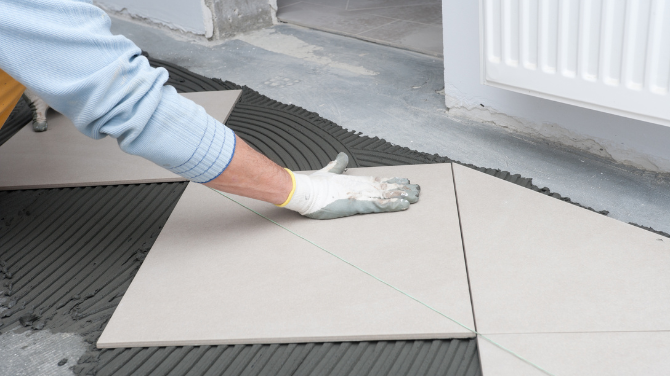Tiling a subfloor can be a daunting task, but with the right information and tools, it can be a manageable and rewarding DIY(Do It Yourself) project. Tiling is not only an aesthetic upgrade, but it also provides a durable and water-resistant surface that can withstand high-traffic areas. The key to a successful tiling project is proper preparation, selecting the right tile and adhesive, and ensuring proper installation. This guide will walk you through the necessary steps and materials to properly tile your subfloor, including preparing the surface, choosing the right tile and adhesive, and properly laying and grouting the tile. With a little bit of patience and attention to detail, you’ll be able to transform your subfloor into a beautiful and functional surface that will last for years to come. So without wasting any time, let’s further ado,
Important Steps Before Should be Taken Before Tiling Your Subfloor
Before beginning a tiling project on your subfloor, several important steps must be taken to ensure the project is successful.
These steps include:
Assessing the condition of the subfloor
The first step in any tiling project is to assess the condition of the subfloor. This includes checking for any cracks, uneven areas, or other damage that may need to be repaired before beginning the project. It’s also important to ensure that the subfloor is clean and free of any debris or obstacles.
Removing the existing flooring
If there is existing flooring on the subfloor, it will need to be removed before beginning the tiling project. This can be a labor-intensive process, so it may be necessary to hire a professional to remove the old flooring.
Repairing any damage
Once the existing flooring has been removed, any damage to the subfloor should be repaired. This may include filling in cracks, leveling out uneven areas, or replacing damaged sections of the subfloor.
Cleaning the subfloor
After any repairs have been made, the subfloor should be thoroughly cleaned to remove any remaining debris or dust. This will help ensure that the tile adheres properly to the subfloor.
Installing a moisture barrier
In areas where moisture is a concern, it’s important to install a moisture barrier before beginning the tiling project. This will help prevent water from seeping through the subfloor and causing damage to the tile or the subfloor itself.
Checking for level
Make sure the subfloor is level before starting the tile installation. A self-leveling compound can be used to level any uneven surfaces.
Planning the tile layout
Planning the tile layout is essential before beginning installation. Ensure proper fit and design, this involves locating the room’s center and practicing tile placement.
Gather the materials
It is crucial to acquire all of the required supplies, such as tile, adhesive, spacers, a tile cutter, and grout, before starting the tiling process. By following these important steps before tiling your subfloor, you can ensure that the project is successful and the final result is a beautiful and functional surface that will last for years to come. Remember that it’s always a good idea to seek professional help if you’re unsure about any step of the process.
Key Benefits of Tiling Your Subfloor
Tiling a subfloor offers several benefits that make it a popular choice for both residential and commercial properties.
Here are some of the main benefits of tiling your subfloor:
● Durability
Tile is a very durable and long-lasting material, making it an excellent choice for high-traffic areas. It can withstand heavy foot traffic, as well as heavy furniture and equipment. This makes it perfect for areas such as kitchens, bathrooms, and entryways.
● Water resistance
Due to its water resistance, tile is a fantastic material choice for moist locations. As a result, it is perfect for use in bathrooms, kitchens, and laundry rooms. The most water-resistant alternatives are porcelain and ceramic tile.
● Easy to maintain
Tiled floors are easy to clean and maintain. They can be swept or vacuumed to remove dirt and debris and can be wiped down with a damp mop to remove spills and stains. Additionally, tile is resistant to mildew and mold, making it a hygienic option for areas where moisture may be present.
● Aesthetically pleasing
It’s simple to locate tile that matches the general aesthetic of your house or commercial property because it comes in so many different colors, designs, and textures. There are countless options, from conventional ceramic to natural stone.
● Cost-effective
While the initial cost of tiling a subfloor may be higher than other flooring options, tile is an economical choice in the long run. The tile is durable and long-lasting, which means it will need to be replaced less often than other flooring options.
● Easy to repair
If a tile becomes damaged, it is relatively easy to remove and replace just that tile. This is much easier than replacing an entire floor, which can be costly and time-consuming.
● Increased value
Tiling a subfloor is a great way to increase the value of your property. A well-maintained tile floor can make a home or commercial property more attractive to potential buyers. In short, tiling a subfloor is a cost-effective, durable, and easy-to-maintain option that also offers aesthetic benefits. It’s a great way to increase the value of your property and can be a DIY project for those willing to take the time and care to plan and execute the project. It’s always a good idea to seek professional help if you’re unsure about any step of the process.
Conclusion
In conclusion, tiling a subfloor can be a challenging but rewarding DIY project. With proper preparation, the right tile and adhesive, and proper installation techniques, you can achieve professional results. Remember to always assess the condition of your subfloor, remove any existing flooring, make any necessary repairs, clean the subfloor, install a moisture barrier, check for level, plan the tile layout, and gather all the necessary materials. Tiling your subfloor will not only enhance the aesthetic appeal of your space but also will provide a durable and water-resistant surface that can withstand high-traffic areas. By following this guide, you can confidently tackle the tiling project and create a beautiful and functional surface that will last for years to come.
Redwop has carved a name for itself in the realm of flooring material and solution manufacturing. Owing to our range of solutions, expertise, and innovative products we have earned the trust of thousands of distributors and customers across the world map. Whether you are looking for first-rate epoxy floorings, cementitious floorings, or PU floorings, Redwop is the one-stop destination for all your needs.

